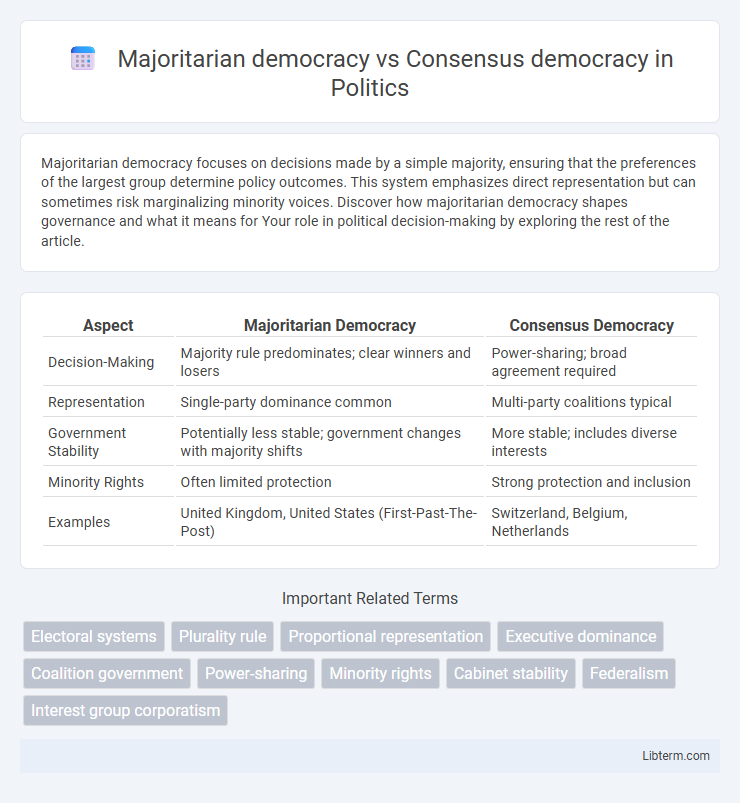Majoritarian democracy focuses on decisions made by a simple majority, ensuring that the preferences of the largest group determine policy outcomes. This system emphasizes direct representation but can sometimes risk marginalizing minority voices. Discover how majoritarian democracy shapes governance and what it means for Your role in political decision-making by exploring the rest of the article.
Table of Comparison
| Aspect | Majoritarian Democracy | Consensus Democracy |
|---|---|---|
| Decision-Making | Majority rule predominates; clear winners and losers | Power-sharing; broad agreement required |
| Representation | Single-party dominance common | Multi-party coalitions typical |
| Government Stability | Potentially less stable; government changes with majority shifts | More stable; includes diverse interests |
| Minority Rights | Often limited protection | Strong protection and inclusion |
| Examples | United Kingdom, United States (First-Past-The-Post) | Switzerland, Belgium, Netherlands |
Defining Majoritarian Democracy
Majoritarian democracy is characterized by the concentration of power in the hands of the majority, where decisions reflect the preferences of the largest voting bloc, often resulting in a winner-takes-all approach. This system emphasizes single-party governance, clear electoral outcomes, and the dominance of the majority in legislative processes. It contrasts sharply with consensus democracy, which seeks to include diverse political actors and minority interests through power-sharing and cooperative decision-making mechanisms.
Understanding Consensus Democracy
Consensus democracy emphasizes broad agreement and inclusion of diverse political groups, aiming to prevent domination by a single majority. It features power-sharing mechanisms, proportional representation, and coalition governments to ensure minority voices influence decision-making. This system promotes stability and legitimacy by fostering cooperation and compromise among multiple parties.
Historical Origins and Development
Majoritarian democracy originated primarily in 19th-century Britain emphasizing rule by the majority through single-party dominance and clear legislative accountability, reflecting the centralization of power in Westminster's parliamentary system. Consensus democracy developed post-World War II in countries like Switzerland and the Netherlands, promoting power-sharing, proportional representation, and coalition governments to ensure broad societal inclusiveness and minority protections. The historical trajectory of majoritarian systems highlights simplicity and decisiveness, while consensus models evolved to address pluralism and social cleavages in increasingly diverse societies.
Core Principles of Majoritarian Systems
Majoritarian democracy emphasizes the principle of majority rule where the largest group in society holds decisive power, often through a single-party government and winner-takes-all electoral systems. It prioritizes clear accountability, swift decision-making, and the concentration of political authority in the hands of the majority, typically marginalizing minority interests. Core features include unitary government structure, two-party dominance, and plurality voting systems that reinforce the dominance of the largest political faction.
Key Features of Consensus Systems
Consensus democracy is characterized by power-sharing mechanisms, broad coalition governments, and inclusive decision-making processes that emphasize compromise and cooperation among diverse political groups. It often includes proportional representation electoral systems, federal or decentralized structures, and strong protections for minority rights to ensure balanced participation. These key features contrast with majoritarian democracy's tendency toward winner-takes-all outcomes and concentrated executive power.
Electoral Mechanisms and Representation
Majoritarian democracy relies on single-member district electoral systems, such as first-past-the-post, which tend to produce clear winners and promote two-party systems, ensuring decisive governance but often marginalizing smaller groups. Consensus democracy employs proportional representation methods, including party-list or mixed-member systems, to allocate seats more equitably among diverse political parties, enhancing inclusivity and minority representation. The contrast in electoral mechanisms directly shapes the nature of political representation, with majoritarian models favoring majority rule and consensus models fostering broader coalition-building and power-sharing.
Decision-Making Processes Compared
Majoritarian democracy relies on majority rule, where decisions are typically made by a simple majority, enabling swift and decisive policy implementation. Consensus democracy emphasizes broad agreement, requiring negotiation and compromise among diverse political actors to achieve inclusive and stable decisions. This process often involves coalition-building and power-sharing mechanisms to ensure that multiple voices influence the final outcomes.
Government Stability and Policy Outcomes
Majoritarian democracy often produces stable governments through single-party rule, enabling swift policy implementation but risking marginalization of minority groups. Consensus democracy emphasizes broad coalition-building, leading to more inclusive and balanced policy outcomes, though it may result in slower decision-making and less government stability due to frequent compromises. Research indicates consensus systems typically yield higher policy quality and durability, while majoritarian regimes excel in decisive governance during crises.
Strengths and Weaknesses of Each Model
Majoritarian democracy centralizes decision-making power, enabling swift and decisive governance, which promotes political stability but risks marginalizing minority groups and fostering adversarial politics. Consensus democracy emphasizes inclusive decision-making and power-sharing among diverse groups, enhancing legitimacy and minority representation while often leading to slower decision processes and potential gridlock. Each model's effectiveness depends on societal diversity, political culture, and the need for either efficiency or inclusiveness in governance.
Implications for Modern Democratic Governance
Majoritarian democracy emphasizes concentrated decision-making power, typically resulting in swift policy implementation but risks marginalizing minority groups, which can undermine social cohesion. Consensus democracy prioritizes inclusive governance by incorporating diverse political actors and promoting broad agreement, enhancing legitimacy and stability in pluralistic societies. Modern democratic governance often balances these models to ensure efficient decision-making while protecting minority rights and fostering political cooperation.
Majoritarian democracy Infographic

 libterm.com
libterm.com